2011 NISSAN 370Z COUPE belt
[x] Cancel search: beltPage 48 of 419
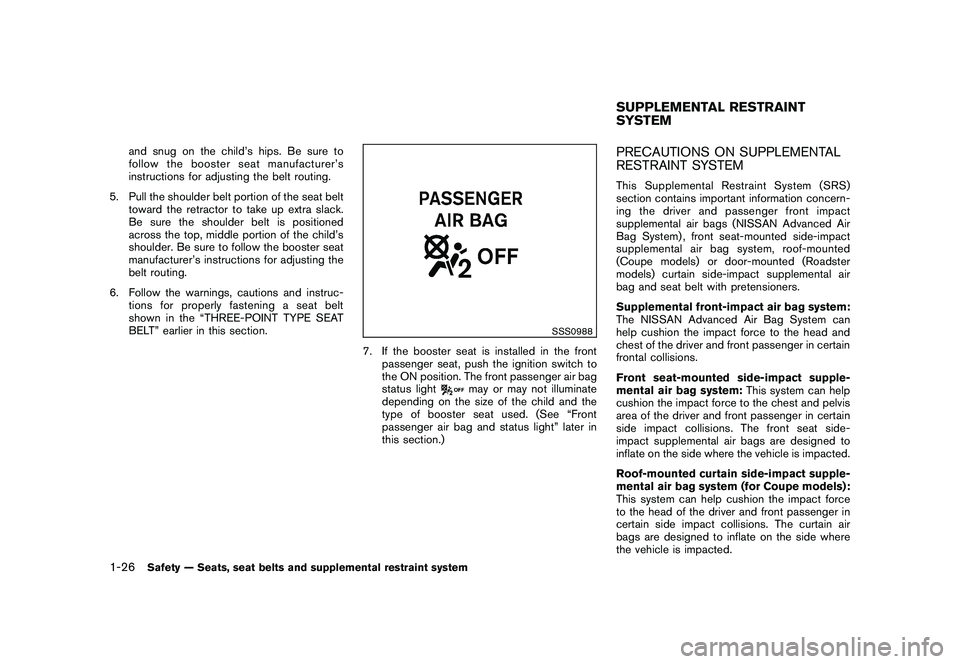
Black plate (44,1)
Model "Z34-D" EDITED: 2010/ 7/ 27
and snug on the child’s hips. Be sure to
follow the booster seat manufacturer’s
instructions for adjusting the belt routing.
5. Pull the shoulder belt portion of the seat belt toward the retractor to take up extra slack.
Be sure the shoulder belt is positioned
across the top, middle portion of the child’s
shoulder. Be sure to follow the booster seat
manufacturer’s instructions for adjusting the
belt routing.
6. Follow the warnings, cautions and instruc- tions for properly fastening a seat belt
shown in the “THREE-POINT TYPE SEAT
BELT” earlier in this section.
SSS0988
7. If the booster seat is installed in the frontpassenger seat, push the ignition switch to
the ON position. The front passenger air bag
status light
may or may not illuminate
depending on the size of the child and the
type of booster seat used. (See “Front
passenger air bag and status light” later in
this section.)
PRECAUTIONS ON SUPPLEMENTAL
RESTRAINT SYSTEMThis Supplemental Restraint System (SRS)
section contains important information concern-
ing the driver and passenger front impact
supplemental air bags (NISSAN Advanced Air
Bag System) , front seat-mounted side-impact
supplemental air bag system, roof-mounted
(Coupe models) or door-mounted (Roadster
models) curtain side-impact supplemental air
bag and seat belt with pretensioners.
Supplemental front-impact air bag system:
The NISSAN Advanced Air Bag System can
help cushion the impact force to the head and
chest of the driver and front passenger in certain
frontal collisions.
Front seat-mounted side-impact supple-
mental air bag system: This system can help
cushion the impact force to the chest and pelvis
area of the driver and front passenger in certain
side impact collisions. The front seat side-
impact supplemental air bags are designed to
inflate on the side where the vehicle is impacted.
Roof-mounted curtain side-impact supple-
mental air bag system (for Coupe models):
This system can help cushion the impact force
to the head of the driver and front passenger in
certain side impact collisions. The curtain air
bags are designed to inflate on the side where
the vehicle is impacted.SUPPLEMENTAL RESTRAINT
SYSTEM
1-26
Safety — Seats, seat belts and supplemental restraint system
Page 49 of 419
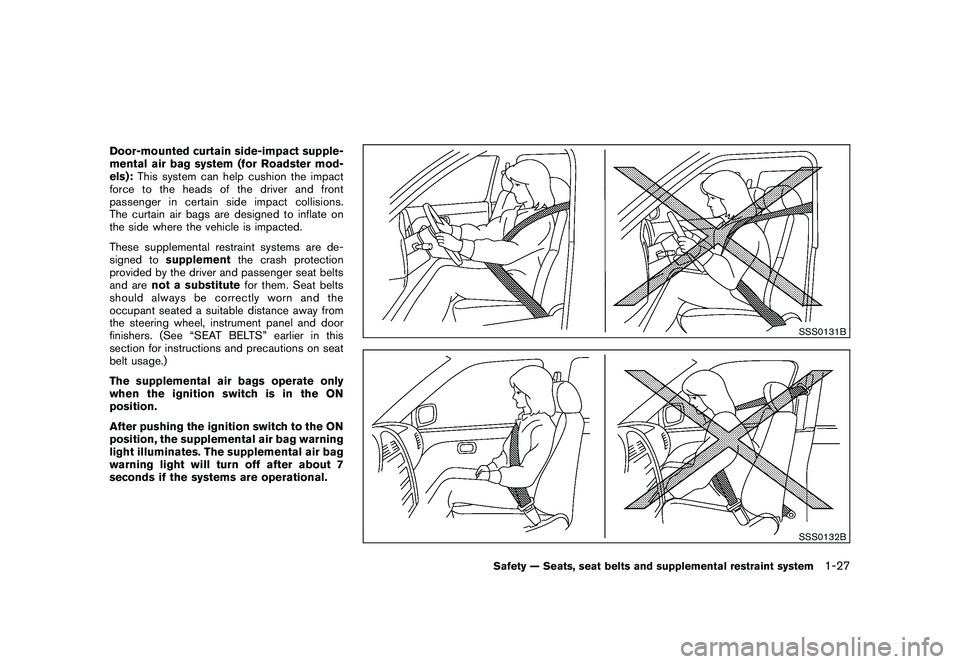
Black plate (45,1)
Model "Z34-D" EDITED: 2010/ 7/ 27
Door-mounted curtain side-impact supple-
mental air bag system (for Roadster mod-
els):This system can help cushion the impact
force to the heads of the driver and front
passenger in certain side impact collisions.
The curtain air bags are designed to inflate on
the side where the vehicle is impacted.
These supplemental restraint systems are de-
signed to supplement the crash protection
provided by the driver and passenger seat belts
and are not a substitute for them. Seat belts
should always be correctly worn and the
occupant seated a suitable distance away from
the steering wheel, instrument panel and door
finishers. (See “SEAT BELTS” earlier in this
section for instructions and precautions on seat
belt usage.)
The supplemental air bags operate only
when the ignition switch is in the ON
position.
After pushing the ignition switch to the ON
position, the supplemental air bag warning
light illuminates. The supplemental air bag
warning light will turn off after about 7
seconds if the systems are operational.
SSS0131BSSS0132B
Safety — Seats, seat belts and supplemental restraint system
1-27
Page 50 of 419
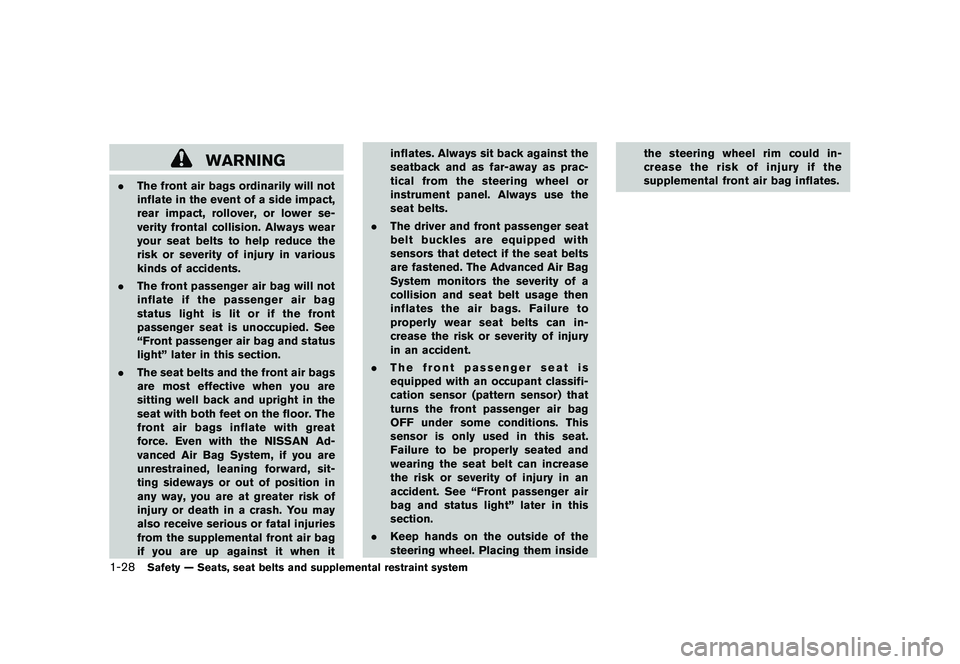
Black plate (46,1)
Model "Z34-D" EDITED: 2010/ 7/ 27
WARNING
.The front air bags ordinarily will not
inflate in the event of a side impact,
rear impact, rollover, or lower se-
verity frontal collision. Always wear
your seat belts to help reduce the
risk or severity of injury in various
kinds of accidents.
. The front passenger air bag will not
inflate if the passenger air bag
status light is lit or if the front
passenger seat is unoccupied. See
“Front passenger air bag and status
light” later in this section.
. The seat belts and the front air bags
are most effective when you are
sitting well back and upright in the
seat with both feet on the floor. The
front air bags inflate with great
force. Even with the NISSAN Ad-
vanced Air Bag System, if you are
unrestrained, leaning forward, sit-
ting sideways or out of position in
any way, you are at greater risk of
injury or death in a crash. You may
also receive serious or fatal injuries
from the supplemental front air bag
if you are up against it when it inflates. Always sit back against the
seatback and as far-away as prac-
tical from the steering wheel or
instrument panel. Always use the
seat belts.
. The driver and front passenger seat
belt buckles are equipped with
sensors that detect if the seat belts
are fastened. The Advanced Air Bag
System monitors the severity of a
collision and seat belt usage then
inflates the air bags. Failure to
properly wear seat belts can in-
crease the risk or severity of injury
in an accident.
. The front passenger seat is
equipped with an occupant classifi-
cation sensor (pattern sensor) that
turns the front passenger air bag
OFF under some conditions. This
sensor is only used in this seat.
Failure to be properly seated and
wearing the seat belt can increase
the risk or severity of injury in an
accident. See “Front passenger air
bag and status light” later in this
section.
. Keep hands on the outside of the
steering wheel. Placing them inside the steering wheel rim could in-
crease the risk of injury if the
supplemental front air bag inflates.1-28
Safety — Seats, seat belts and supplemental restraint system
Page 51 of 419
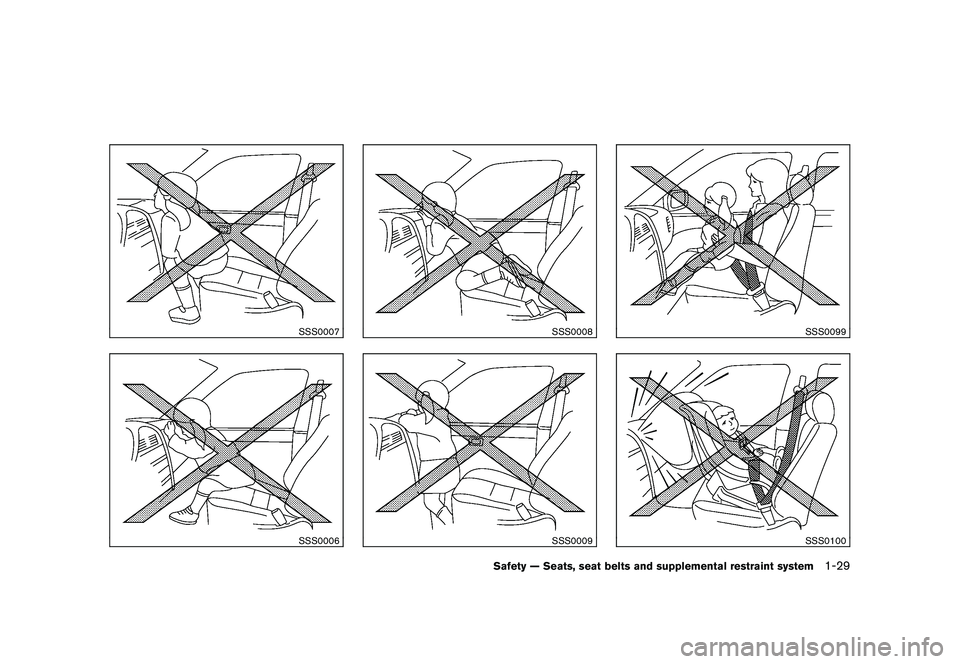
Black plate (47,1)
Model "Z34-D" EDITED: 2010/ 7/ 27
SSS0007SSS0006
SSS0008SSS0009
SSS0099SSS0100
Safety — Seats, seat belts and supplemental restraint system
1-29
Page 52 of 419

Black plate (48,1)
Model "Z34-D" EDITED: 2010/ 7/ 27
WARNING
.Never let children ride unrestrained
or extend their hands or face out of
the window. Do not attempt to hold
them in your lap or arms. Some
examples of dangerous riding posi-
tions are shown in the illustrations.
. Children may be severely injured or
killed when the front air bags, side
air bags or curtain air bags inflate if
they are not properly restrained.
. Even with the NISSAN Advanced Air
Bag System, never install a rear-
facing child restraint in the front
seat. An inflating front air bag could
seriously injure or kill your child.
See “CHILD RESTRAINTS” earlier in
this section for details.
SSS0059ASSS0162
SSS0159
WARNING
Front seat-mounted side-impact sup-
plemental air bags and roof-mounted
(Coupe models) or door-mounted
(Roadster models) curtain side-impact
supplemental air bags:
.The front seat-mounted side-impact
air bags and roof-mounted (Coupe
models) or door-mounted (Roadster
models) curtain air bags ordinarily
will not inflate in the event of a
frontal impact, rear impact, rollover
or lower severity side collision. Al-
1-30
Safety — Seats, seat belts and supplemental restraint system
Page 53 of 419
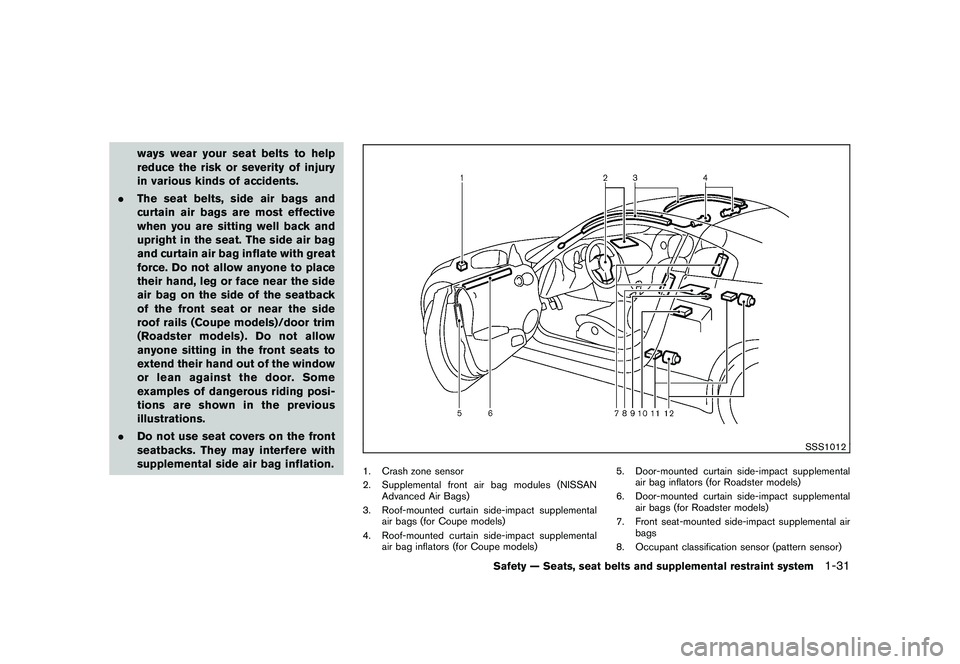
Black plate (49,1)
Model "Z34-D" EDITED: 2010/ 7/ 27
ways wear your seat belts to help
reduce the risk or severity of injury
in various kinds of accidents.
. The seat belts, side air bags and
curtain air bags are most effective
when you are sitting well back and
upright in the seat. The side air bag
and curtain air bag inflate with great
force. Do not allow anyone to place
their hand, leg or face near the side
air bag on the side of the seatback
of the front seat or near the side
roof rails (Coupe models)/door trim
(Roadster models) . Do not allow
anyone sitting in the front seats to
extend their hand out of the window
or lean against the door. Some
examples of dangerous riding posi-
tions are shown in the previous
illustrations.
. Do not use seat covers on the front
seatbacks. They may interfere with
supplemental side air bag inflation.
SSS1012
1. Crash zone sensor
2. Supplemental front air bag modules (NISSAN
Advanced Air Bags)
3. Roof-mounted curtain side-impact supplemental air bags (for Coupe models)
4. Roof-mounted curtain side-impact supplemental air bag inflators (for Coupe models) 5. Door-mounted curtain side-impact supplemental
air bag inflators (for Roadster models)
6. Door-mounted curtain side-impact supplemental air bags (for Roadster models)
7. Front seat-mounted side-impact supplemental air bags
8. Occupant classification sensor (pattern sensor)
Safety — Seats, seat belts and supplemental restraint system
1-31
Page 54 of 419
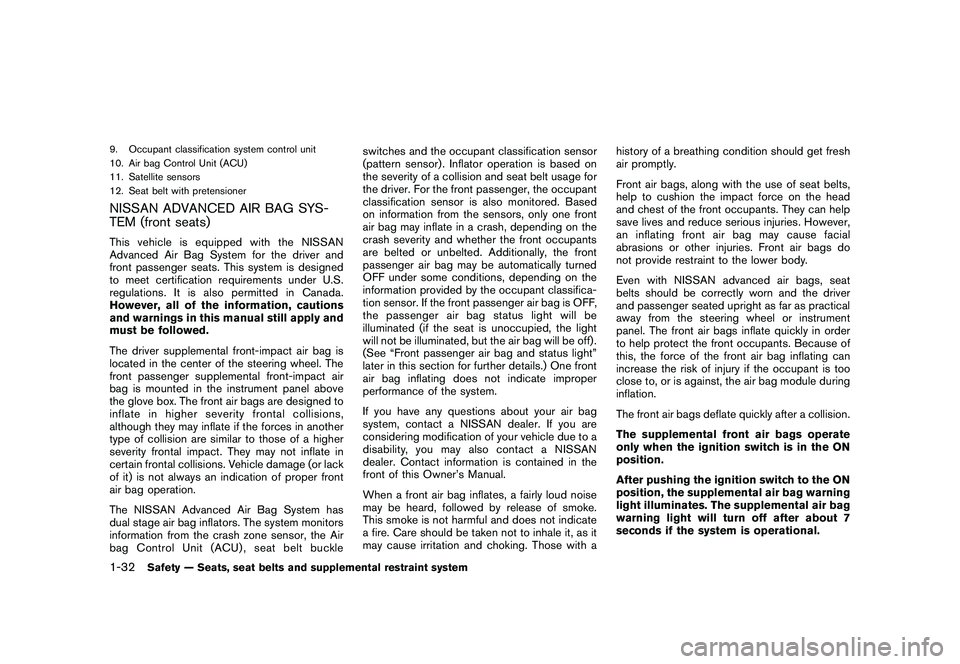
Black plate (50,1)
Model "Z34-D" EDITED: 2010/ 7/ 27
9. Occupant classification system control unit
10. Air bag Control Unit (ACU)
11. Satellite sensors
12. Seat belt with pretensionerNISSAN ADVANCED AIR BAG SYS-
TEM (front seats)This vehicle is equipped with the NISSAN
Advanced Air Bag System for the driver and
front passenger seats. This system is designed
to meet certification requirements under U.S.
regulations. It is also permitted in Canada.
However, all of the information, cautions
and warnings in this manual still apply and
must be followed.
The driver supplemental front-impact air bag is
located in the center of the steering wheel. The
front passenger supplemental front-impact air
bag is mounted in the instrument panel above
the glove box. The front air bags are designed to
inflate in higher severity frontal collisions,
although they may inflate if the forces in another
type of collision are similar to those of a higher
severity frontal impact. They may not inflate in
certain frontal collisions. Vehicle damage (or lack
of it) is not always an indication of proper front
air bag operation.
The NISSAN Advanced Air Bag System has
dual stage air bag inflators. The system monitors
information from the crash zone sensor, the Air
bag Control Unit (ACU) , seat belt buckleswitches and the occupant classification sensor
(pattern sensor) . Inflator operation is based on
the severity of a collision and seat belt usage for
the driver. For the front passenger, the occupant
classification sensor is also monitored. Based
on information from the sensors, only one front
air bag may inflate in a crash, depending on the
crash severity and whether the front occupants
are belted or unbelted. Additionally, the front
passenger air bag may be automatically turned
OFF under some conditions, depending on the
information provided by the occupant classifica-
tion sensor. If the front passenger air bag is OFF,
the passenger air bag status light will be
illuminated (if the seat is unoccupied, the light
will not be illuminated, but the air bag will be off) .
(See “Front passenger air bag and status light”
later in this section for further details.) One front
air bag inflating does not indicate improper
performance of the system.
If you have any questions about your air bag
system, contact a NISSAN dealer. If you are
considering modification of your vehicle due to a
disability, you may also contact a NISSAN
dealer. Contact information is contained in the
front of this Owner’s Manual.
When a front air bag inflates, a fairly loud noise
may be heard, followed by release of smoke.
This smoke is not harmful and does not indicate
a fire. Care should be taken not to inhale it, as it
may cause irritation and choking. Those with a
history of a breathing condition should get fresh
air promptly.
Front air bags, along with the use of seat belts,
help to cushion the impact force on the head
and chest of the front occupants. They can help
save lives and reduce serious injuries. However,
an inflating front air bag may cause facial
abrasions or other injuries. Front air bags do
not provide restraint to the lower body.
Even with NISSAN advanced air bags, seat
belts should be correctly worn and the driver
and passenger seated upright as far as practical
away from the steering wheel or instrument
panel. The front air bags inflate quickly in order
to help protect the front occupants. Because of
this, the force of the front air bag inflating can
increase the risk of injury if the occupant is too
close to, or is against, the air bag module during
inflation.
The front air bags deflate quickly after a collision.
The supplemental front air bags operate
only when the ignition switch is in the ON
position.
After pushing the ignition switch to the ON
position, the supplemental air bag warning
light illuminates. The supplemental air bag
warning light will turn off after about 7
seconds if the system is operational.1-32
Safety — Seats, seat belts and supplemental restraint system
Page 55 of 419
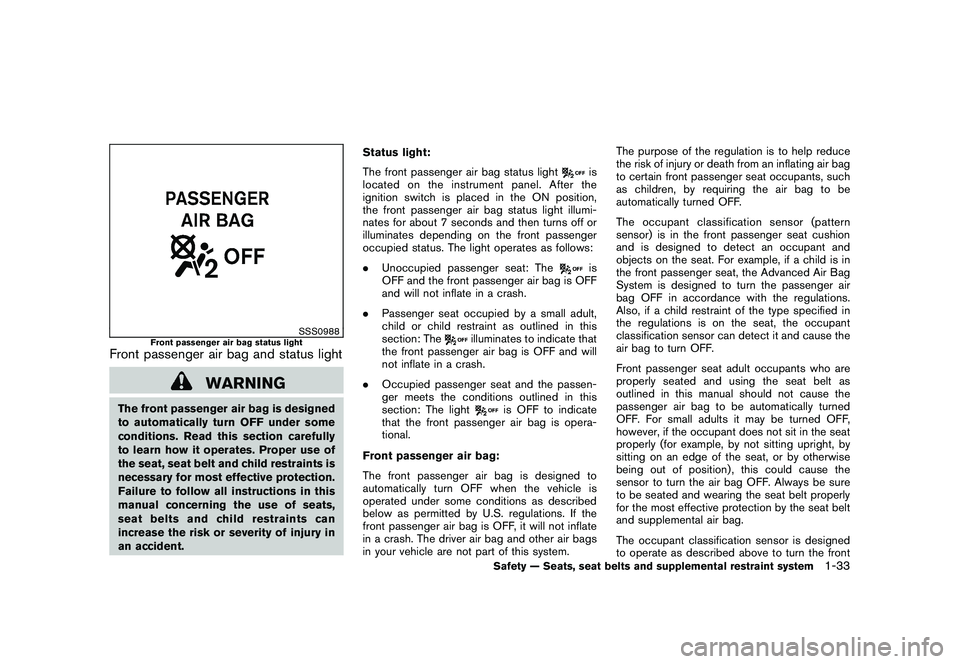
Black plate (51,1)
Model "Z34-D" EDITED: 2010/ 7/ 27
SSS0988
Front passenger air bag status light
Front passenger air bag and status light
WARNING
The front passenger air bag is designed
to automatically turn OFF under some
conditions. Read this section carefully
to learn how it operates. Proper use of
the seat, seat belt and child restraints is
necessary for most effective protection.
Failure to follow all instructions in this
manual concerning the use of seats,
seat belts and child restraints can
increase the risk or severity of injury in
an accident.Status light:
The front passenger air bag status light
is
located on the instrument panel. After the
ignition switch is placed in the ON position,
the front passenger air bag status light illumi-
nates for about 7 seconds and then turns off or
illuminates depending on the front passenger
occupied status. The light operates as follows:
. Unoccupied passenger seat: Theis
OFF and the front passenger air bag is OFF
and will not inflate in a crash.
. Passenger seat occupied by a small adult,
child or child restraint as outlined in this
section: The
illuminates to indicate that
the front passenger air bag is OFF and will
not inflate in a crash.
. Occupied passenger seat and the passen-
ger meets the conditions outlined in this
section: The light
is OFF to indicate
that the front passenger air bag is opera-
tional.
Front passenger air bag:
The front passenger air bag is designed to
automatically turn OFF when the vehicle is
operated under some conditions as described
below as permitted by U.S. regulations. If the
front passenger air bag is OFF, it will not inflate
in a crash. The driver air bag and other air bags
in your vehicle are not part of this system. The purpose of the regulation is to help reduce
the risk of injury or death from an inflating air bag
to certain front passenger seat occupants, such
as children, by requiring the air bag to be
automatically turned OFF.
The occupant classification sensor (pattern
sensor) is in the front passenger seat cushion
and is designed to detect an occupant and
objects on the seat. For example, if a child is in
the front passenger seat, the Advanced Air Bag
System is designed to turn the passenger air
bag OFF in accordance with the regulations.
Also, if a child restraint of the type specified in
the regulations is on the seat, the occupant
classification sensor can detect it and cause the
air bag to turn OFF.
Front passenger seat adult occupants who are
properly seated and using the seat belt as
outlined in this manual should not cause the
passenger air bag to be automatically turned
OFF. For small adults it may be turned OFF,
however, if the occupant does not sit in the seat
properly (for example, by not sitting upright, by
sitting on an edge of the seat, or by otherwise
being out of position) , this could cause the
sensor to turn the air bag OFF. Always be sure
to be seated and wearing the seat belt properly
for the most effective protection by the seat belt
and supplemental air bag.
The occupant classification sensor is designed
to operate as described above to turn the frontSafety — Seats, seat belts and supplemental restraint system
1-33